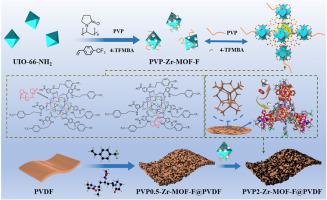制备具有 PVP 诱导氟化 Zr-MOF 的混合基质膜,用于高湿度条件下的高效氢气纯化
IF 8.4
1区 工程技术
Q1 ENGINEERING, CHEMICAL
引用次数: 0
摘要
由于制氢过程中经常会产生二氧化碳、甲烷、水和烷烃等杂质,因此氢气纯化对全球绿色能源应用至关重要。使用金属有机框架(MOF)材料的混合基质膜(MMM)为氢气纯化提供了一种非热、高能效的方法。这些膜具有可控结构,促进了环境的可持续发展。然而,在制备 MOF-MMMs 的过程中,填料聚集和基质-填料不相容等难题难以避免,并可能对分离性能产生不利影响。本研究在 UiO-66-NH2 上原位引入 4-(三氟甲基)苯甲酸(4-TFMBA)与聚乙烯吡咯烷酮(PVP)同步生长,形成疏水双功能纳米粒子复合材料 PVP-Zr-MOF-F。此外,还采用湿法和 NIPS 技术将 PVP-Zr-MOF-F 原位负载到 PVDF 聚合物基体上,制备出 PVP-Zr-MOF-F@PVDF。4-TFMBA 具有高电负性的 F 原子,它的引入增强了疏水性,并通过 C-F 键引起的极化和氢键增加了 H2 亲和力。PVP 可促进形成更小的 Zr-MOF 颗粒,增加小孔的比例,防止聚集,并作为孔形成剂,促进 PVP-Zr-MOF-F 在 PVDF 链中的原位装载和分散。这种双官能化不仅提高了纳米填料的相容性和分散性,还增加了小孔的数量,增强了对 H2 分子的范德华力和约束效应,使其适用于潮湿条件下的气体分离。结果表明,PVP2-Zr-MOF-F@PVDF 的 H2 渗透率可达 114,735 GPU,对 H2/CO2、H2/CH4、H2/C2H4 和 H2/n-C6H14 的选择性分别为 19、21、24 和 120,超过了 2008 年 Robeson 的上限。值得注意的是,在高湿度条件下,H2/CO2、H2/CH4 和 H2/n-C6H14 的选择性分别比原来的 PVDF 膜高出 1566 %、1891 % 和 3264 %,实现了高选择性分离。此外,在不同湿度下重复实验后,膜的选择性几乎保持不变,这表明 PVP2-Zr-MOF-F@PVDF 具有很高的水热稳定性。这项研究为氢气提纯提供了新的参考,对绿色能源的可持续发展具有重要意义。本文章由计算机程序翻译,如有差异,请以英文原文为准。

Preparation of mixed matrix membranes with PVP-induced fluorinated Zr-MOF for high-efficiency hydrogen purification under high humidity conditions
Given that hydrogen production often involves impurities such as CO2, CH4, H2O, and alkanes, hydrogen purification is crucial for global green energy applications. Mixed matrix membranes (MMMs) using metal-organic framework (MOF) materials offer a non-thermal, energy-efficient method for hydrogen purification. These membranes have controllable structures and promote environmental sustainability. However, challenges such as filler aggregation and matrix-filler incompatibility during the preparation of MOF-MMMs are difficult to avoid and can adversely affect separation performance. In this study, 4-(trifluoromethyl) benzoic acid (4-TFMBA) was introduced in situ to grow synchronously with polyvinyl pyrrolidone (PVP) on UiO-66-NH2, forming a hydrophobic bifunctional nanoparticle composite, PVP-Zr-MOF-F. Furthermore, in situ loading of PVP-Zr-MOF-F onto a PVDF polymer matrix was achieved using a wet method and the NIPS technique to prepare PVP-Zr-MOF-F@PVDF. The introduction of 4-TFMBA, with highly electronegative F atoms, enhances hydrophobicity and increases H2 affinity through polarization and hydrogen bonding induced by C–F bonds. PVP promotes the formation of smaller Zr-MOF particles, increases the proportion of small pores, prevents aggregation, and acts as a pore-forming agent, facilitating the in situ loading and dispersion of PVP-Zr-MOF-F within PVDF chains. This bifunctionalization not only improves the compatibility and dispersion of the nanofillers but also increases the number of small pores, enhancing van der Waals forces and confinement effects on H2 molecules, making it suitable for gas separation under humid conditions. The results indicate that the H2 permeance of PVP2–Zr-MOF-F@PVDF can reach 114,735 GPU, with selectivities of 19, 21, 24, and 120 for H2/CO2, H2/CH4, H2/C2H4, and H2/n-C6H14, respectively, surpassing the 2008 Robeson's upper bound. Notably, under high humidity conditions, the selectivities for H2/CO2, H2/CH4, and H2/n-C6H14 are 1566 %, 1891 %, and 3264 % higher than those of the original PVDF membrane, achieving high selectivity separation. Additionally, after repetitive experiments with varying humidity, the membrane's selectivity remained almost unchanged, demonstrating the high hydrothermal stability of PVP2–Zr-MOF-F@PVDF. This research provides a new reference for hydrogen purification and holds significant implications for the sustainable development of green energy.
求助全文
通过发布文献求助,成功后即可免费获取论文全文。
去求助
来源期刊

Journal of Membrane Science
工程技术-高分子科学
CiteScore
17.10
自引率
17.90%
发文量
1031
审稿时长
2.5 months
期刊介绍:
The Journal of Membrane Science is a publication that focuses on membrane systems and is aimed at academic and industrial chemists, chemical engineers, materials scientists, and membranologists. It publishes original research and reviews on various aspects of membrane transport, membrane formation/structure, fouling, module/process design, and processes/applications. The journal primarily focuses on the structure, function, and performance of non-biological membranes but also includes papers that relate to biological membranes. The Journal of Membrane Science publishes Full Text Papers, State-of-the-Art Reviews, Letters to the Editor, and Perspectives.
 求助内容:
求助内容: 应助结果提醒方式:
应助结果提醒方式:


